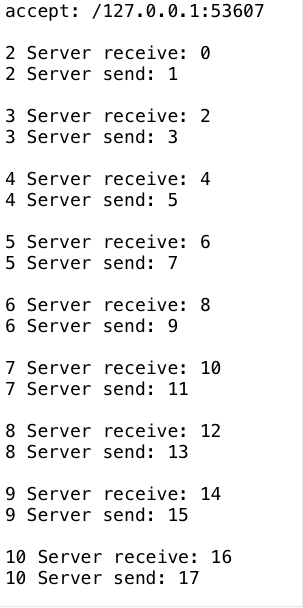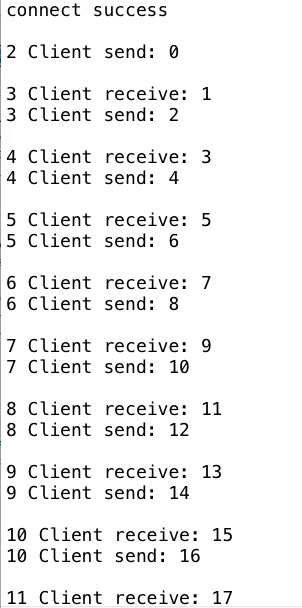Java基础--NIO
NIO库在JDK1.4中引入,它以标准Java代码提供了高速的,面向块的IO,弥补了之前同步IO的不足。
缓冲区Buffer
Buffers是一个对象,包含了一些要写入或读出的数据。在面向流的IO模型中,数据是直接写入或读出到Stream对象中的,在NIO中,所有数据都是用缓冲区处理的,在读取数据时,数据直接读到缓冲区中,写入数据时直接写到缓冲区,在任何时候访问NIO中的数据都要通过缓冲区。缓冲区是基于数组实现的,同时提供了对数据的结构化访问并且维护了读写位置。一个ByteBuffer提供了一组功能用于操作byte数组,每种Java类型都对应了一种缓冲区:CharBuffer字符缓冲区,Shortbuffer短整型缓冲区,IntBuffer整型缓冲区,LongBuffer长整型缓冲区,FloatBuffer浮点型缓冲区,DoubleBuffer双精度浮点缓冲区。每一个Buffer类都是Buffer接口的子实例,每一个Buffer类都有完全一样的操作,只是操作的数据类型不一样,ByteBuffer在一般缓冲区操作外提供了一些特有的操作。
缓冲区是包在一个对象内的基本数据元素数组,其有四个重要属性
容量( Capacity):缓冲区能够容纳的数据元素的最大数量,容量在缓冲区创建时被设定,并且永远不能被改变。
上界(Limit):缓冲区的第一个不能被读或写的元素。或者说,缓冲区中现存元素的计数。
位置(Position):下一个要被读或写的元素的索引。位置会自动由相应的 get( )和 put( )函数更新。
标记(Mark):一个备忘位置。调用 mark( )来设定 mark = postion。调用 reset( )设定 position = mark。标记在设定前是未定义的(undefined)。
四个属性之间的关系如下: 0 <= mark <= position <= limit <= capacity
初始时,mark未被设定,position为0,capacity为10,limit为10,第一个元素存放至position为0的位置,capacity不变,其他三个属性会变化。position在调用 put()时,会自动指出了下一个数据元素应该被插入的位置,或者当 get()被调用时指出下一个元素应从何处取出。当put完数据后需要读取时,需要调用flip函数,其将limit设置为position,然后将position设置为0, 之后开始读取。
buffer常见方法如下:
- flip(): 写模式转换成读模式
- rewind():将 position 重置为 0 ,一般用于重复读。
- clear() :清空 buffer ,准备再次被写入 (position 变成 0 , limit 变成 capacity) 。
- compact(): 将未读取的数据拷贝到 buffer 的头部位。
- mark(): reset():mark 可以标记一个位置, reset 可以重置到该位置。
通道Channel
Channel是一个通道,如水管一样,网络数据通过Channel读取和写入,通道是双向的,流是单向的,一个流必须是InputStream或者OutputStream的子类,通道可以用于读写同时进行,所以它是全双工的。Channel可以分为两大类,用于网络读写的SelectableChannel和用于文件操作的FileChannel,ServerSocketChannel和SocketChannel都是SelectableChannel的子类。
Channel接口类只定义了两个方法(isOpen和close),分别表示通道是否打开和关闭通道,具体细节需要子类实现。
IO操作可分为File IO和Stream IO,对应通道也有它们是文件( file)通道和套接字( socket)通道 。通道可以有多种方式创建。Socket 通道有可以直接创建新 socket 通道的工厂方法。但File通道不能直接创建,只能通过在一个打开的RandomAccessFile、FileInputStream或FileOutputStream的对象上调用getChannel( )方法来获取。
通道将数据传输给 ByteBuffer 对象或者从 ByteBuffer 对象获取数据进行传输,通道可以是单向或者双向的。一个 channel 类可能实现定义read( )方法的 ReadableByteChannel 接口,而另一个 channel 类也许实现 WritableByteChannel 接口以提供 write( )方法。实现这两种接口其中之一的类都是单向的,一个类同时实现这两个接口,那么它是双向的,如ByteChannel 接口。从 FileInputStream 对象的getChannel( )方法获取的 FileChannel 对象是只读的,不过从接口声明的角度来看却是双向的,因为FileChannel 实现 ByteChannel 接口。在这样一个通道上调用 write( )方法将抛出未经检查的NonWritableChannelException 异常,因为 FileInputStream 对象总是以 read-only 的权限打开文件。
通道会连接一个特定 I/O 服务且通道实例( channel instance)的性能受它所连接的 I/O 服务的特征限制。如一个连接到只读文件的 Channel 实例不能进行写操作,即使该实例所属的类可能有 write( )方法。
通道可以以阻塞( blocking)或非阻塞( nonblocking)模式运行,非阻塞模式的通道永远不会让调用的线程休眠。请求的操作要么立即完成,要么返回一个结果表明未进行任何操作。只有面向流的( stream-oriented)的通道,如 sockets 和 pipes 才能使用非阻塞模式。通道不能被重复使用,一个打开的通道即代表与一个特定 I/O 服务的特定连接并封装该连接的状态。当通道关闭时,连接会丢失,通道将不再连接任何东西。
1. FileChannel写文件,读文件
public class FileChannelTest {
static void write() throws IOException {
File file = new File("test");
FileOutputStream outputStream = new FileOutputStream(file);
FileChannel channel = outputStream.getChannel();
ByteBuffer buffer = ByteBuffer.allocate(128);
String string = "123 456 abcd EFG !@#$% 测试";
buffer.put(string.getBytes());
buffer.flip();
channel.write(buffer);
channel.close();
outputStream.close();
}
static void read() throws IOException {
File file = new File("test.txt");
FileInputStream inputStream = new FileInputStream(file);
FileChannel channel = inputStream.getChannel();
ByteBuffer buffer = ByteBuffer.allocate(128);
channel.read(buffer);
buffer.flip();
String string = new String(buffer.array());
System.out.print(string);
}
public static void main(String[] args) throws IOException {
write();
read();
}
}
---
2.使用Channel接收和发送数据
public class ChannelServer {
public static void main(String[] args) throws Exception {
ServerSocketChannel serverSocketChannel = ServerSocketChannel.open();
ServerSocket serverSocket = serverSocketChannel.socket();
serverSocketChannel.configureBlocking(false);
serverSocket.bind(new InetSocketAddress("localhost", 8080));
int count = 0;
SocketChannel socketChannel = null;
ByteBuffer byteBuffer = ByteBuffer.allocate(512);
while (count < 20) {
if (socketChannel == null) {
socketChannel = serverSocketChannel.accept();
} else {
count++;
byteBuffer.clear();
socketChannel.read(byteBuffer);
byteBuffer.flip();
String message = getString(byteBuffer);
System.out.println(count + " server received: " + message);
byteBuffer.clear();
byteBuffer.put(message.getBytes());
byteBuffer.flip();
socketChannel.write(byteBuffer);
System.out.println(count + " server send: " + message);
}
TimeUnit.MILLISECONDS.sleep(500);
}
serverSocketChannel.close();
}
public static String getString(ByteBuffer buffer) {
Charset charset = Charset.forName("UTF-8");
CharBuffer charBuffer = charset.decode(buffer);
return charBuffer.toString();
}
}
---
public class ChannelClient {
public static void main(String[] args) throws Exception {
SocketChannel socketChannel = SocketChannel.open();
socketChannel.connect(new InetSocketAddress("localhost", 8080));
ByteBuffer byteBuffer = ByteBuffer.allocate(512);
int count = 0;
while (count < 20) {
count++;
String message = "message " + count;
byteBuffer.clear();
byteBuffer.put(message.getBytes());
byteBuffer.flip();
socketChannel.write(byteBuffer);
System.out.println(count + " client send: " + message);
byteBuffer.clear();
int readBytes = socketChannel.read(byteBuffer);
if (readBytes > 0) {
byteBuffer.flip();
System.out.println(count + " client receive: " + getString(byteBuffer));
}
}
socketChannel.close();
}
public static String getString(ByteBuffer buffer) {
Charset charset = Charset.forName("UTF-8");
CharBuffer charBuffer = charset.decode(buffer.asReadOnlyBuffer());
return charBuffer.toString();
}
}
---
多路复用Selector
Selector是NIO的基础,Selector提供了选择已经就绪的任务的能力,它会不断的轮询注册在其上的Channel,如果某个Channel上发生读或者写事件,这个Channel就出于就绪状态,会被Selector轮询出来,然后通过SelectingKey可以获取就绪的Channel集合,进行后续的IO操作。一个Selector可以同时轮询多个Channel,由于JDK使用了epoll代替传统的select实现,所以它并没有最大连接句柄的限制。
选择器管理一个被注册的通道集合的信息和它们的就绪状态,通道和选择器一起被注册,并且选择器可更新通道的就绪状态,也可将被唤醒的线程挂起,直到有通道就绪。
SelectableChannel 可被注册到 Selector 对象上,同时可以指定对那个选择器而言,哪种操作是感兴趣的。一个通道可以被注册到多个选择器上,但对每个选择器而言,只能被注册一次,通道在被注册到一个选择器上之前,必须先设置为非阻塞模式,通过调用通道的configureBlocking(false)方法即可。这意味着不能将FileChannel与Selector一起使用,因为FileChannel不能切换到非阻塞模式,而套接字通道都可以。
选择键封装了特定的通道与特定的选择器的注册关系,选择键对象被SelectableChannel.register( ) 方法返回并提供一个表示这种注册关系的标记。选择键包含了两个比特集(以整数的形式进行编码),指示了该注册关系所关心的通道操作及通道已经准备好的操作。
3. 使用Selector发送和接收数据
package com.luangeng.jdk.nio; import com.luangeng.utils.Q; import java.io.IOException;
import java.net.InetSocketAddress;
import java.nio.ByteBuffer;
import java.nio.channels.SelectionKey;
import java.nio.channels.Selector;
import java.nio.channels.ServerSocketChannel;
import java.nio.channels.SocketChannel;
import java.nio.charset.Charset;
import java.util.Iterator;
import java.util.concurrent.TimeUnit; public class NioServer { private static final Charset charset = Charset.forName("UTF-8"); public static void main(String[] args) throws IOException, InterruptedException { int count = 0; int msgValue = 0; //打开ServerSocketChannel,用于监听客户端的连接,是所有客户端连接的父管道
ServerSocketChannel serverChannel = ServerSocketChannel.open(); //绑定监听端口,设置连接为非阻塞模式
serverChannel.socket().bind(new InetSocketAddress("localhost", 8080));
serverChannel.configureBlocking(false); //创建Reactor线程,创建多路复用器并启动线程
Selector selector = Selector.open(); //将SercerSocketChannel注册到Reactor线程的多路复用器Selector上监听ACCEPT事件
serverChannel.register(selector, SelectionKey.OP_ACCEPT); while (true) {
//多路复用器在线程run方法中无限循环体内轮询准备就绪的Key
int num = selector.select();
if (num == 0) {
continue;
} Iterator it = selector.selectedKeys().iterator();
while (it.hasNext()) {
count++;
SelectionKey key = (SelectionKey) it.next(); if (key.isAcceptable()) {
//多路复用器监听到有新的客户端接入,处理新的接入请求,完成TCP三次握手,建立物理链路
SocketChannel channel = serverChannel.accept(); //设置客户端链路为非阻塞状态
channel.configureBlocking(false);
channel.socket().setReuseAddress(true); //将新接入的客户端连接注册到Reactor线程的多路复用器上,监听读操作,读取客户端发送的网络信息
channel.register(selector, SelectionKey.OP_READ | SelectionKey.OP_WRITE);
Q.p("accept: " + channel.getRemoteAddress());
}
if (key.isReadable()) {
SocketChannel channel = (SocketChannel) key.channel();
//异步读取客户端请求消息到缓冲区
ByteBuffer buffer = ByteBuffer.allocate(1024);
channel.read(buffer);
buffer.flip();
String msg = charset.decode(buffer).toString();
Q.p(count + " Server receive: " + msg);
msgValue = Integer.valueOf(msg.trim()) + 1;
buffer.clear();
}
if (key.isValid() && key.isWritable()) {
SocketChannel channel = (SocketChannel) key.channel();
channel.write(charset.encode("" + msgValue));
Q.p(count + " Server send: " + msgValue);
} Q.p();
it.remove();
TimeUnit.SECONDS.sleep(2);
}
//if (msgValue==100){
// break;
//}
} //关闭
//selector.close();
//serverChannel.close();
} }
---
package com.luangeng.jdk.nio; import com.luangeng.utils.Q; import java.io.IOException;
import java.net.InetSocketAddress;
import java.net.Socket;
import java.nio.ByteBuffer;
import java.nio.channels.SelectionKey;
import java.nio.channels.Selector;
import java.nio.channels.SocketChannel;
import java.nio.charset.Charset;
import java.util.Iterator;
import java.util.concurrent.TimeUnit; public class NioClient { private static final int BUFFER_SIZE = 1024; private static final Charset charset = Charset.forName("UTF-8"); public static void main(String[] args) throws IOException, InterruptedException { int count = 0;
int msgValue = 0; //打开SocketChannel,绑定客户端本地地址(可选,默认系统会随机分配一个可用的本地地址)
SocketChannel clientChannel = SocketChannel.open(); //设置SocketChannel为非阻塞模式,同时设置客户端连接的TCP参数
clientChannel.configureBlocking(false); Socket socket = clientChannel.socket();
socket.setReuseAddress(true);
socket.setReceiveBufferSize(BUFFER_SIZE);
socket.setSendBufferSize(BUFFER_SIZE); //创建Reactor线程,创建多路复用器并启动线程
Selector selector = Selector.open(); //异步连接服务端
boolean connected = clientChannel.connect(new InetSocketAddress("localhost", 8080)); //向Reactor线程的多路复用器注册OP_CONNECT状态位,监听服务器端的TCP ACK应答
clientChannel.register(selector, SelectionKey.OP_CONNECT); while (true) {
//多路复用器在线程run方法的无限循环体内轮询准备就绪的Key
int num = selector.select();
if (num == 0) {
continue;
} Iterator it = selector.selectedKeys().iterator();
while (it.hasNext()) {
count++;
SelectionKey key = (SelectionKey) it.next(); //接收connect事件进行处理
if (key.isConnectable()) {
//判断连接成功,如果成功,注册读事件到多路复用器
if (clientChannel.finishConnect()) {
Q.p("connect success");
//clientChannel.register(selector, SelectionKey.OP_READ | SelectionKey.OP_WRITE);
key.interestOps(SelectionKey.OP_READ | SelectionKey.OP_WRITE);
}
} if (key.isReadable()) {
//异步读取客户端请求消息到缓冲区
ByteBuffer buffer = ByteBuffer.allocate(1024);
clientChannel.read(buffer);
buffer.flip();
String msg = charset.decode(buffer).toString();
Q.p(count + " Client receive: " + msg);
msgValue = Integer.valueOf(msg.trim()) + 1;
buffer.clear();
}
if (key.isValid() && key.isWritable()) {
//调用SocketChannel的异步write接口,将消息异步发送给客户端
clientChannel.write(charset.encode("" + msgValue));
Q.p(count + " Client send: " + msgValue);
} Q.p();
it.remove();
TimeUnit.SECONDS.sleep(2);
}
if (msgValue == 20) {
clientChannel.finishConnect();
Q.p("finish");
//break;
}
} //关闭连接
//selector.close();
//clientChannel.close();
} }
---
输出:


end
Java基础--NIO的更多相关文章
- Java基础——NIO(一)通道与缓冲区
一.概述 1.什么是NIO NIO即New IO,这个库是在JDK1.4中才引入的.NIO和IO有相同的作用和目的,但实现方式不同,NIO主要用到的是块,所以NIO的效率要比IO高很多. 在Java ...
- Java基础——NIO(二)非阻塞式网络通信与NIO2新增类库
一.NIO非阻塞式网络通信 1.阻塞与非阻塞的概念 传统的 IO 流都是阻塞式的.也就是说,当一个线程调用 read() 或 write() 时,该线程被阻塞,直到有一些数据被读取或写入,该线程在 ...
- java基础-网络编程(Socket)技术选型入门之NIO技术
java基础-网络编程(Socket)技术选型入门之NIO技术 作者:尹正杰 版权声明:原创作品,谢绝转载!否则将追究法律责任. 一.传统的网络编程 1>.编写socket通信的MyServer ...
- JAVA基础(10)——IO、NIO
转载:http://blog.csdn.net/weitry/article/details/52964948 JAVA基础系列规划: JAVA基础(1)——基本概念 JAVA基础(2)——数据类型 ...
- Java基础之NIO
NIO简介: Java NIO(New IO)是从Java 1.4版本开始引入的一个新的IO API,可以替代标准的Java IO API.NIO与原来的IO有同样的作用和目的,但是使用的方式完全不同 ...
- [Java面经]干货整理, Java面试题(覆盖Java基础,Java高级,JavaEE,数据库,设计模式等)
如若转载请注明出处: http://www.cnblogs.com/wang-meng/p/5898837.html 谢谢.上一篇发了一个找工作的面经, 找工作不宜, 希望这一篇的内容能够帮助到大 ...
- 万能的林萧说:一篇文章教会你,如何做到招聘要求中的“要有扎实的Java基础”。
来历 本文来自于一次和群里猿友的交流,具体的情况且听LZ慢慢道来. 一日,LZ在群里发话,"招人啦." 然某群友曰,"群主,俺想去." LZ回之,"你 ...
- java基础-java核心知识库
本人从事java开发6年左右,主要从事互联网相关的开发,目前还是奋战在一线的码农,痛并快乐着.受互联网产品热潮的影响,关注高性能低成本架构,互联网开发框架,以下是我认为作为一个资深java程序员应该掌 ...
- Java基础之读文件——使用通道读取混合数据2(ReadPrimesMixedData2)
控制台程序,本例读取Java基础之写文件部分(PrimesToFile2)写入的Primes.txt. 方法二:设置一个任意容量的.大小合适的字节缓冲区并且使用来自文件的字节进行填充.然后整理出缓冲区 ...
随机推荐
- laravel中设置表单的方式,以及获取表单的提交的数据
- Systems
package com.System; public class Study01 { /* * System 包含一些游泳的类字段和方法 * 继承自java.lang包 * JDK1.0开始 * 全部 ...
- 通过ping 主机名,或者主机名对应的IP地址
通过ping 主机名,或者主机名对应的IP地址: 如下图: 懵了吧? 但是你用 ping 主机名 -4
- js 预处理 与 执行 的顺序
链接 浏览器渲染 js先编译, 后执行, 而且先在第一块代码段编译执行, 再到第二个代码段, 代码段之间是可以共享变量的 DOMContentLoaded
- (二) ffmpeg filter学习--混音实现
Audio 混音实现 从FFMPEG原生代码doc/examples/filtering_audio.c修改而来. ffmpeg版本信息 ffmpeg version N-82997-g557c0df ...
- Android深入理解JNI(二)类型转换、方法签名和JNIEnv
相关文章 Android深入理解JNI系列 前言 上一篇文章介绍了JNI的基本原理和注册,这一篇接着带领大家来学习JNI的数据类型转换.方法签名和JNIEnv. 1.数据类型的转换 首先给出上一篇文章 ...
- Linux RTC Test Example rtctest.c hacking
/********************************************************************** * Linux RTC Test Example rtc ...
- learn go passing variable-length arguments
package main // 参考文档: // https://github.com/Unknwon/the-way-to-go_ZH_CN/blob/master/eBook/06.3.md im ...
- [Java]如何为一个自定义类型的List排序。
好吧,三年了,又重拾我的博客了,是因为啥呢,哈哈哈.今天被问到一个题目,当场答不出来,动手动的少了,再此记录下来. Q:有一个MyObject类型的List,MyObject定义如下: class M ...
- Uoj 441 保卫王国
Uoj 441 保卫王国 动态 \(dp\) .今天才来写这个题. 设 \(f[u][0/1]\) 表示子树 \(u\) 中不选/选 \(u\) 时的最小权值和,显然有:\(f[u][0]=\sum ...
